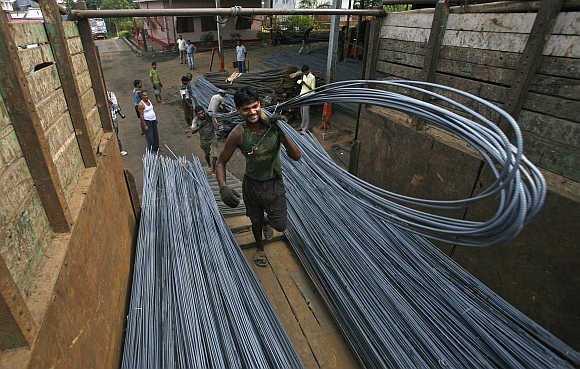 | « Back to article | Print this article |
Bonded labour practice thriving in modern forms
Bonded labour may have been abolished in India in 1976, but the practice not only continues, experience of grass-roots workers suggests it is becoming more widespread.
We might be experiencing a relative decline in the incidence of hereditary bondage, but India's rapidly evolving economic structure and inadequate livelihood security for the most vulnerable sections of society are giving rise to newer and more complex forms of bonded labour.
These may not necessarily be lifelong encumbrances, may even be voluntary at times, but are instances of bondage, nonetheless. Migration, driven by uneven growth in different parts of the country, is one of the most important drivers of present-day bondage.
Click NEXT to read more...
Bonded labour practice thriving in modern forms
Slow economic growth and a rapidly growing population mean that there are few jobs available for the burgeoning workforce in the poorer states.
Take Punjab and Bihar, for example. While the ratio between relative incomes in the two states has worsened from 1.7 in 1965 to about four at present, the population of Bihar has grown much more rapidly.
Between 2001-11, while the population of Punjab grew by roughly 14 per cent, that of Bihar grew by 25 per cent, and on a much larger base. These conditions lead to large-scale migration from states such as Bihar, Jharkhand, Odisha and so on towards states such as Punjab, Haryana and Andhra Pradesh and Tamil Nadu.
Click NEXT to read more...
Bonded labour practice thriving in modern forms
While the advent of the MGNREGS (Mahatma Gandhi National Rural Employment Guarantee Act) might have helped slow the flow of labour, large- scale migration of farm labour during the cropping season is still a reality across India.
Another form of migration is that of the landless and marginal landowners to urban areas in order to find gainful employment. Such migrants typically end up in industries such as construction, brick kilns, or in hazardous industries such as waste collection and are prone to exploitation.
Migrant workers often have to endure inhuman working conditions. They are often kept in confinement and are subject to multiple forms of coercion.
Click NEXT to read more...
Bonded labour practice thriving in modern forms
A typical form of exploitation of workers in urban areas is forcing them to purchase their daily groceries on credit from specific stores. These stores are owned by the employer, and charge a very high interest on the credit they extend to workers. When the time to collect wages comes, workers typically owe the stores a significant part of their earnings in dues and interest, and end up making barely subsistence-level wages.
Lack of awareness of the choices available to them, and explicit as well as implicit intimidation by employers means that the workers seldom venture to seek other employment. This can be described as nothing but bondage.
Click NEXT to read more...
Bonded labour practice thriving in modern forms
Conditions very similar to bonded labour can also be seen in the handloom textile industry in many parts of India, and in the garment industry, where sweatshops working for big brands employ workers in large numbers.
Again, these semi-skilled workers endure many hardships and are bonded labour in all but name. Instances of bondage in brick kilns, rice mills, stone quarries, fishing farms and so on are well-documented.
Hearing a petition against the continued existence of bonded labour in India on October 15, the Supreme Court was constrained to observe that the practice of bonded labour was rampant across India, and ask the states to take up a comprehensive survey on the prevalence of the issue.
Click NEXT to read more...
Bonded labour practice thriving in modern forms
While the Bonded Labour System (Prohibition) Act has provisions for such surveys to be conducted periodically, no state has undertaken any survey for a long time. There is, thus, no reliable estimate on the number of bonded labourers in the country. The administration is understandably reluctant to admit that the problem exists, as this would reflect poorly on them.
However, it is high time that we stopped wishing that the problem would go away if we do not acknowledge it, and to take up the fight against bondage on a national level. Better enforcement of the law would be of little use if steps to improve rehabilitation of released workers are also not taken.
Click NEXT to read more...
Bonded labour practice thriving in modern forms
The present provisions for rehabilitation are far too weak and released workers often relapse into bondage owing to absence of any other livelihood options.
In addition to increasing the relief available to released workers, we also need to look at how the various schemes for livelihood such as the National Rural Livelihood Mission can be tweaked to have a special focus on released workers.
The continued existence of bonded labour, in spite of a constitutional mandate against it, and a strong law in form of the Bonded Labour System (Abolition) Act 1976, is a blot on modern day India.
Click NEXT to read more...
Bonded labour practice thriving in modern forms
Section 4 of the Bonded Labour System (Abolition) Act unequivocally states: "On the commencement of this Act, the bonded labour system shall stand abolished and every bonded labourer shall, on such commencement, stand freed and discharged from any obligation to render any bonded labour."
The major causes driving modern day bondage are poverty and absence of a social security net in the country. The government is making some welcome moves towards addressing the vulnerabilities that cause people to enter bondage, and schemes such as MGNREGS have also helped improve livelihood security.
Click NEXT to read more...
Bonded labour practice thriving in modern forms
It is important for the government and grass-roots organisations to partner in a better, more meaningful manner so that each can complement the other. A closer partnership will help further inclusive growth for all Indians.
The author is Director of National Advocacy at the International Justice Mission, Delhi, and part of a multi-agency campaign against bonded labour









